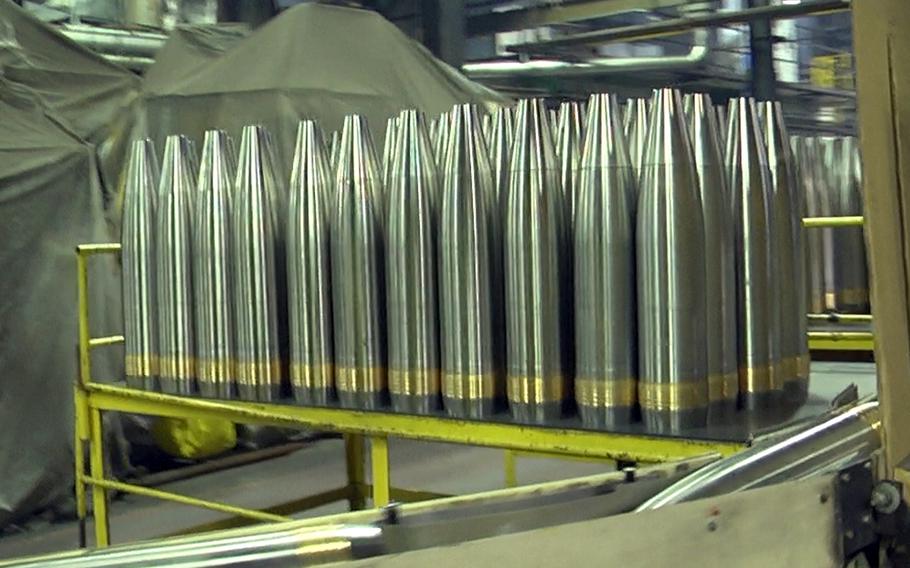
A U.S. soldier holds up a belt of 7.62 mm rounds during an M240B machine gun qualification range at Camp Atterbury, Ind., in 2015. There was a decline in annual global arms revenue in 2022, according to a new report by the Stockholm International Peace Research Institute. Preliminary data suggests an upswing for weapons contractors in 2023. (Michel Sauret/U.S. Army)
Major weapons manufacturers around the globe saw declines in overall revenue last year despite strong demand from the war in Ukraine and other conflicts, a watchdog group said Monday, but initial earnings data suggest major U.S. contractors have rebounded.
The top 100 global arms producers and military services companies generated $597 billion in 2022, a 3.5% drop in real terms from 2021, according to a report released Monday by the Stockholm International Peace Research Institute, or SIPRI.
Revenue drops among major U.S. companies were largely to blame for the worldwide dip, the report said, adding that labor shortages, rising costs and supply chain disruptions exacerbated by the Russia-Ukraine war hampered efforts by the U.S. and its allies to significantly increase production throughout the year.
“Many arms companies faced obstacles in adjusting to production for high-intensity warfare,” Lucie Béraud-Sudreau, director of SIPRI’s military expenditure and arms production program, said in a statement released with the report.
The revenues of the 42 U.S. companies in the top 100 fell by nearly 8% last year to just over $300 billion. All but 10 recorded a year-on-year fall in arms revenue, the data showed.
However, so far this year, major U.S. companies like Lockheed Martin, Northrop Grumman and Boeing all have posted sales increases each quarter.

Projectile production at Scranton Army Ammunition Plant at Rock Island Arsenal, Ill. Global arms revenue declined last year despite demand for weapons being driven up by conflicts, according to a new report by the Stockholm International Peace Research Institute. Preliminary data suggests an upswing for weapons contractors in 2023. (Dori Whipple/Scranton Army Ammunition Plant)
While that alone doesn’t guarantee higher annual revenues, stock repurchases and shareholder dividends by Lockheed, the largest global contractor, are among some of the indicators that the industry’s global revenue is headed upward. General Dynamics, in earnings announcements, said their revenue increased each quarter this year.
Only two Russian companies were included in the top 100 last year. Their combined revenues fell 12% to $108 billion, SIPRI said.
Reduced transparency in Russia and a lack of data were the reasons the report cited for the scarcity of Russian weapons firms on the list.
Many new orders were placed late in the year, and a gap between orders and production meant actual demand wasn’t reflected in the companies’ 2022 revenues, SIPRI said.
“This highlights the often lengthy time lag between the initial demand for weapons and the subsequent scaling up of production and delivery by arms companies, especially when severe capacity constraints already exist,” the report said.
The arms revenue of the seven Middle Eastern companies included in the ranking rose collectively by 11% to just under $18 billion. It was the largest annual percentage increase in arms revenue when assessed by region.
The 22 companies from Asia and Oceania also saw an overall increase of 3.1% to reach $134 billion, marking the second consecutive year that arms revenues from Asia and Oceania were higher than those from Europe.
“Domestic demand and reliance on local suppliers shielded Asian arms companies from supply chain disruptions in 2022,” SIPRI researcher Xiao Liang said in the statement. “Companies in China, India, Japan and Taiwan all benefited from sustained government investment in military modernization.”
The aggregate revenues of the eight Chinese arms companies in the ranking increased by nearly 3%, to $108 billion, according to the SIPRI data.
Despite the overall year-on-year decrease, the collective revenue among the top 100 global companies was still 14% higher in 2022 than in 2015, the first year that SIPRI began including Chinese companies in the ranking.